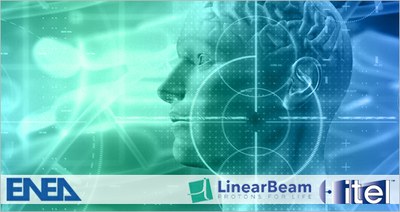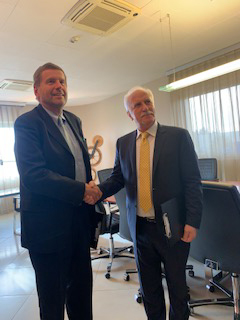Health: ENEA-ITEL agreement for innovative proton therapy systems
30/1/2020
 A scientific alliance has been forged between the worlds of research and of industry, with a view to developing highly innovative technologies for increasingly efficacious oncological radiotherapeutics, while limiting invasiveness. This was the objective of the memorandum of understanding signed by the President of ENEA, Federico Testa, and the President of LinearBeam - ITEL Telecomunicazioni, Leonardo Diaferia. The memorandum’s aim is to foster technical and scientific teamwork and exchanges of know-how in order to manufacture compact linear proton accelerators that are capable of treating even the most deep-seated tumours while safeguarding healthy tissues.
A scientific alliance has been forged between the worlds of research and of industry, with a view to developing highly innovative technologies for increasingly efficacious oncological radiotherapeutics, while limiting invasiveness. This was the objective of the memorandum of understanding signed by the President of ENEA, Federico Testa, and the President of LinearBeam - ITEL Telecomunicazioni, Leonardo Diaferia. The memorandum’s aim is to foster technical and scientific teamwork and exchanges of know-how in order to manufacture compact linear proton accelerators that are capable of treating even the most deep-seated tumours while safeguarding healthy tissues.
The memorandum − undersigned on the premises of ITEL at Ruvo di Puglia (in the Province of Bari) in the presence of authorities and representatives of institutions and economic, scientific and academic players − aims to encourage acquisition, exchanges and enhancement of technological knowledge, expertise and professional know-how within the sector for the production of “ERHA” and “TOP-IMPLART” prototypes, as an instance of “knowledge exchange” and of industrial exploitation of technological and scientific capabilities.
“This collaboration enables a convergence between Enea’s technological and scientific skills and the engineering and industrial skills of Itel/Linearbeam. It is of strategic value for enhancing Italy’s leadership position in the scientific and industrial spheres, furthermore within a sector with great potentials for worldwide dissemination, namely particle accelerators”, explained the President of ENEA, Federico Testa. “Indeed, unmediated osmosis among the scientific and engineering human resources of the two parties points to a further added value in terms of the ‘shift’ of expertise onto young researchers and technologists, while speeding up the times required to open the first proton therapy centres in central and southern Italy”.
 Thanks to the TOP-IMPLART system, ENEA gained advanced know-how in this field. TOP-IMPLART is an innovative, compact prototype linear proton accelerator. With increasingly precise release of energy, the benefits accrue greatly in terms of performance, greater therapeutic efficacy, briefer treatments, lower (operational, maintenance) costs, and also a smaller footprint compared to current equipment. Developed by ENEA, Istituto Superiore di Sanità and Istituto Nazionale tumori Regina Elena-IFO-Roma, with funding from Regione Lazio government authority, TOP-IMPLART production is currently underway at ENEA’s Frascati centre.
Thanks to the TOP-IMPLART system, ENEA gained advanced know-how in this field. TOP-IMPLART is an innovative, compact prototype linear proton accelerator. With increasingly precise release of energy, the benefits accrue greatly in terms of performance, greater therapeutic efficacy, briefer treatments, lower (operational, maintenance) costs, and also a smaller footprint compared to current equipment. Developed by ENEA, Istituto Superiore di Sanità and Istituto Nazionale tumori Regina Elena-IFO-Roma, with funding from Regione Lazio government authority, TOP-IMPLART production is currently underway at ENEA’s Frascati centre.
“This piece of equipment is the only item of its kind nationwide. Starting next year, it shall produce a proton beam (65 MeV) to treat ocular melanoma in a clinical context. However, we aim for a 150 MeV beam, i.e. the energy required to treat paediatric tumours and tumours of the head-neck compartment, and a further upgrade (up to 200-250 MeV) to treat even the very deepest-seated tumours”, says Luigi Picardi, heading the lab, Laboratorio Sviluppo di Acceleratori di Particelle e Applicazioni Medicali ENEA (ENEA laboratory for development of particle accelerators and medical applications), not only conducting R&D in the ambit of accelerators and medical applications, but also fostering technology transfer to all Italian companies in this sector. LinearBeam, a spin-off from ITEL was founded to develop a cutting-edge proton therapy system (p- Linac).
ITEL has successfully terminated a project within the context of the “Programma Operativo Nazionale” Ricerca e Competitività 2007-2013 (“National Operational Programme” Research and Competitiveness 2007-2013), co-funded with resources both European (European Regional Development Fund (ERDF)) and Italian (hereinafter, “PON”). The project goes by the name of AMIDERHA and regards study and development of a linear proton accelerator for medical applications. ITEL has patented and produced a robotized system for positioning the patient for proton therapy applications that enables a markedly high level of precision and greater degrees of freedom compared to the currently marketed systems.
This innovative proton therapy system (ERHA –Enhanced Radiotherapy with HAdrons) presents as a leading-edge model for tumour treatment, to which RIF – research and innovation funding – together with Equiter SpA have earmarked about 15 million euros with the aim of, in 4 years, completing the accelerator and clinically operating this technology, production of which is currently underway. “The ERHA project is the first step for the made-in-Italy proton therapy of the future”, concludes Leonardo Diaferia, the president of ITEL.
“It is a significant breakthrough development and an absolutely avant-garde resource for treatment of the most widespread neoplasia conditions. It is the result of years of painstaking research, applied methodology and experimentation, and a challenge taken up by professionals and experts of the first order (in fields ranging from basic physics to complex systems engineering, not to mention robotics and computer vision). A blending and merging of talents dedicated to the tasks at hand, i.e. concretizing a visionary project.
A team of scientists working within an incubator of know-how and excellence. Proton therapy is considered the most advanced available form of radiotherapy. The ERHA system developed by LinearBeam is the first such system in the world to include a p-Linac accelerator specifically developed for clinical use. The programme for exchanges of know-how and expertise with the Enea research body marks progress and an encouraging step forward. It shall back up further efforts in the direction of manufacture and placement of the first linear accelerators in Italy”. Ing. Raffaele Andrea Prisco, manager of the ERHA project on behalf of LinearBeam/ITE, adds, “ERHA requires surface areas of less than 100 m2.
It can therefore be readily installed in most hospitals. The components are all controlled by a single integrated control system with software for planning treatments plus the suite for positioning patients. ITEL has in fact patented a fully robotized system for patient positioning, thereby augmenting treatment precision. ERHA is a ‘modular’ system, endowed with multiple contiguous treatment spaces for releasing gradually increasing quantities of energy. It is therefore immediately usable in radiobiology and then for clinical applications. The proton therapy suite is to be completed within 30 months of commencement of the installation procedure. Hence, from the ninth month on, an experimental radiobiology room shall be made available, and from the eighteenth month on paediatric, orbital and ocular treatment can commence”.
For further information: video material fully viewable concerning the Top Implart system (ENEA Frascati)
